You want your construction site and crew to be compliant with safety regulations. While your crew might have the long-sleeved shirts, work pants and sturdy shoes down pat, safety apparel for construction sites is more complex.
Great employers understand that workplace safety means happier employees and higher productivity.
While you can and should design your site to eliminate workplace hazards, some workplaces are inherently dangerous—hence the need for measures like personal protective equipment (PPE).
Safety apparel protects your employees from bodily harm and you from losses in workers’ compensation.
It’s also worth noting that your employees’ safety gear also speaks for your brand. That’s where fancysweetstx’s custom branded safety clothing comes in; but more on that later.
First, let’s break down the must-have safety apparel for construction workers as recommended by the Occupational Safety and Health Administration (OSHA).
1 - Hi-Vis Protection
Fluorescent yellow and orange safety vests are synonymous with construction sites, and for good reason.
Hi-vis (or high-visibility) clothing is essential, especially for construction sites where vehicles or mobile heavy machinery are present.
Some of these heavy machines have huge blind spots in their immediate front and rear lines of vision. Being readily seen by their operators increases the safety of workers on foot.
Safety yellow (yellow-green), orange, and red are the only fluorescent colors recommended by OSHA for hi-vis. They stand out from their surroundings in both daylight and dark or low light conditions.
Retro-reflective strips increase visibility at night and in low lighting, especially in high-traffic areas (such as when doing road repairs).
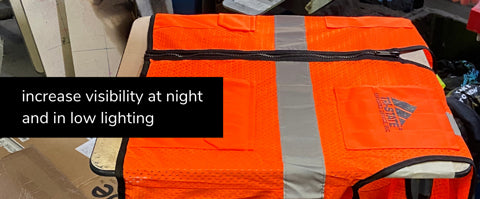
Retro-reflective material is made using thousands of tiny glass beads that reflect a focused image back to the original light source. This makes it easier to identify a worker’s position in poor lighting.
Hi-vis doesn’t stop at sleeveless vests either. From long-sleeved crew neck shirts to hoodies, t-shirts and jackets, hi-vis apparel is the perfect canvas for communicating your brand.
Your crew will be wearing the branded apparel at all times, so you want to be sure that your choice of design and quality speaks to your brand.
With our 10 years of experience, we’ll work with you to design and custom brand the best shirt options for your crew.
2 - Head and Neck Protection
The construction industry has the highest number of traumatic brain injuries compared to all other industries. As such, hard hats that comply with the American National Standards Institute’s (ANSI) standards are essential for all construction workers.
For such a small piece of headgear, helmets have a tremendous responsibility to:
- Absorb the force of impact through their suspension system
- Resist penetration
- Deflect blows to the head
- Be fire-resistant
- Insulate against electric shock
- Prevent top-of-the-head impact from further injuring the spine
- Be impervious to water
ANSI classifies hard hats according to their level of impact protection and the extent of their insulation against electrical voltage.
“Bump caps only protect you from stationary objects and aren’t OSHA or ANSI approved for the hazards on construction sites”
Expert Tip: Each country has its own hard hat standards. For example, ANSI Z89.1 in the US and CSA Z94.1-15 in Canada. Always make sure that the hard hats used on your construction site are correctly labeled and certified according to local regulations.
Let’s not forget about beanies and neck gaiters. Construction work can be extra challenging in extreme weather, like Midwestern winters. You can layer flat-top beanies and balaclavas under hard hats for extra warmth.
In the summer, towels containing cooling gels will keep your neck from overheating in the long hours outside.
3 - Eye Protection
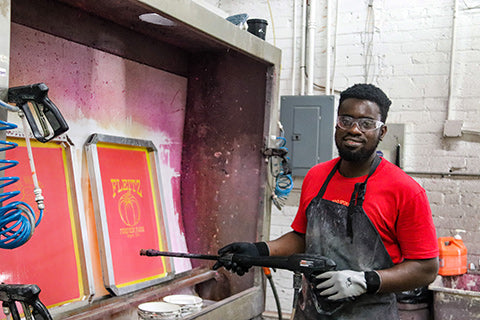
Flying particles, chemical liquids and gases, and harmful light radiation are all commonplace on active construction sites.
OSHA recommends protective eyewear for carpenters, electricians, machinists, plumbers and pipefitters, sanders, grinding machine operators, sawyers, welders, chemical process operators, and timber cutting and logging workers.
Basically, anyone working with tools, machinery, chemicals or light should protect their eyes. We think so too!
The type of safety eyewear you choose will depend on the site’s hazard assessment:
- Safety spectacles: Have metal or plastic safety frames and impact resistant lenses
- Goggles: Fit tightly and protect the eyes and immediate area around the eyes from impact, dust, and splashes
- Welding shields: Protect the eyes from the intense radiant light and the whole face from flying sparks or chips
- Face shields: Pair well with goggles to provide comprehensive eye and facial protection
Expert Tip: If you wear prescription glasses, make sure your goggles fit over them to avoid impairing your vision.
4 - Foot Protection
Combined with the risk of falling objects and bad weather, the fact that construction workers are on their feet for up to 8 hours a day necessitates good footwear.
Construction sites are full of debris, sharp objects, falling objects and uneven and slippery ground.
Make sure your work boots:
- Are safety toe boots that will protect your feet from impact, puncture, and compression
- Offer firm support for your ankles in case the ground is uneven
- Are waterproof, especially in poor weather or wet working conditions
- Have good traction
- Are comfortable to wear for long periods
Expert Tip: After a full day of sweating into your work boots, stuff them with a sock full of cedar chips to eliminate moisture and odors.
5 - Hand Protection
Hands are one of the most adversely affected body parts when it comes to workplace injuries, second only to the torso. Over 100,000 occupational hand injuries occur in the US annually. More than half of these accidents are due to a lack of gloves.
Gloves come in a variety of materials depending on the target hazard:
- Fabric gloves offer minor protection from dirt, slivers, and abrasions
- Plastic-coated fabric gloves offer general protection and slip resistance
- Gloves made of leather, canvas or metal mesh protect against cuts, burns, and sustained heat
- Chemical and liquid resistant gloves, made from different kinds of rubber and blended plastics, protect from chemical burns
- Insulated rubber gloves protect against electrical shock
Expert Tip: Fit is key. Ill-fitting gloves can cause blisters and increase the possibility of an accident occurring because of how they limit your range of motion.
6 - Ear Protection
Construction sites are very loud with noises ranging from 80–120 decibels. That’s the noise range between a compactor and a hammer drill.
In an 8-hour day, 85 decibels is the maximum acceptable noise level a construction worker should endure. Every 3 decibels beyond that reduces the exposure time by half.
Here’s a table showing how exposure time reduces as noise levels increase and which machines correspond to which noise levels.
| Exposure Limit | Noise Level in Decibels (dBA) | Common Construction Machines |
| 8 hours | 85 | Concrete mixer |
| 2 hours | 91 | Welding torch |
| 30 minutes | 97 | Grinder |
| 7.5 minutes | 103 | Concrete chipper |
| 112 seconds | 109 | Impact wrench |
| 28 seconds | 115 | Pile driver |
| 7 seconds | 121 | Chainsaw |
While you can engineer your site and machinery to have sound barriers or to produce less noise, you still need to ensure that your employees are equipped against hazardous noise levels.
Safety apparel has advanced in recent years, and ear protection options are no longer limited to clunky, unwieldy ear muffs.
Ear plugs on the market today have built-in microphones or filter caps that lower noise levels, reaching the ear while enabling the worker to still hear conversation.
Hearing loss doesn’t get the attention it deserves since its onset is slow. Roughly 1 in 5 construction workers experiences hearing impairment which can easily be prevented by using ear protection while on site.
Get Your Safety Apparel Right
Safety apparel is only as good as your usage of it. Train all workers on-site on the proper use of their safety apparel. Regular inspection, careful maintenance, and proper storage will ensure your safety investments benefit you long term.
Above all, getting it right starts with the quality of the safety gear you procure for your construction workers.
If you’re ready to level up your safety game with custom safety apparel for construction, please reach out to us at [email protected] or call us at 419-318-2029 to discuss your options.
Share on Facebook:
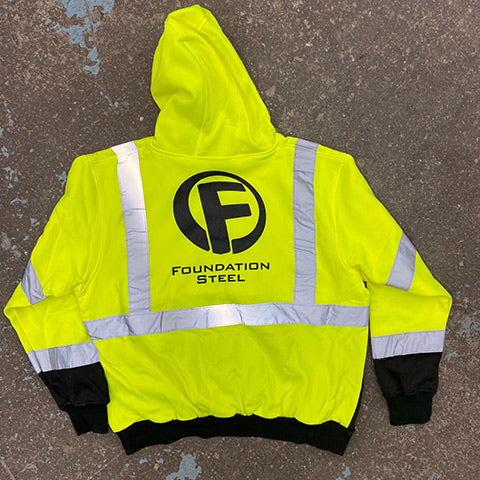
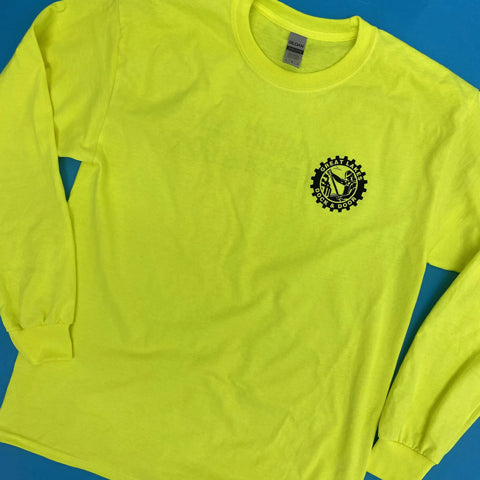
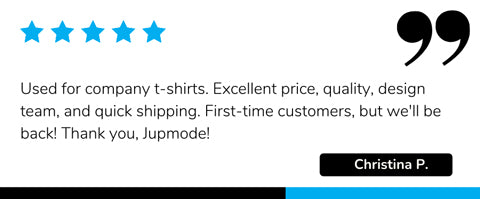
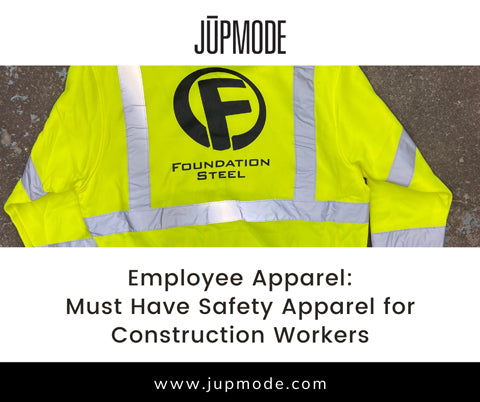









Comments
Write a comment